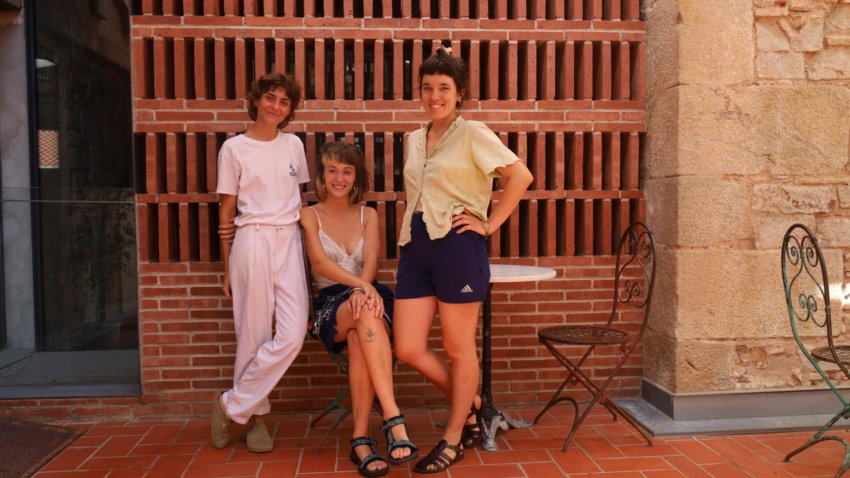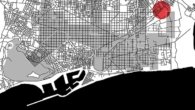
‘Today, while I was coming, they told me that there are no more left’ starts the visual season
Saturday, October 5, the Liberal Arts Center of the Joan Brossa Foundation inaugurates the first exhibition of the 2024-2025 season, ‘Today, while I was coming, I was told that there are no more left‘. An exhibition curated by Helena Calafell, Abril Carretero Balcells and Anna Vilamú Bosch and the result of the Curatorial Research Program (PIC) with the collaboration of the Sala d’Art Jove, which unravels the monster of gentrification from the anecdotes of residents of the neighborhood of Sant Pere, Santa Caterina and la Ribera. The project’s starting point was the contents, questions and reflections left by the exhibition.Carlos Santos And now what?‘ curated by Ona Balló with the collaboration of Helena Lasala, which was seen at La Brossa from March 14 to July 21, 2024.
Why talk about gentrification?
Gentrification is a process that is happening in various contexts and that directly affects people’s lives. Reflecting on this process ends up being a necessity since we are all victims of a city that is becoming, little by little, unlivable. Although we know that this process has specific cases in each context in which it takes place, Sant Pere, Santa Caterina i la Ribera is a neighborhood that is extremely affected by this. When we started participating in the PIC and coming every Tuesday to the neighborhood it became even more obvious to us.
In addition, we wanted our proposal (the day, the appearances and the exhibition) to recognize the context in which it is located and the way to do it was to show what happens in the neighborhood where the Fundació Joan is located trash In fact, the title of the exhibition Today, while I was coming, I was told that there are no more left arises from an interaction with a neighbor, owner of the Mirallers Laundromat, one day when we were looking for a place to buy a snack.
The voices of the residents of Born have a special weight in this exhibition.
The aim of our proposal is to collect the voices of everyone who participates, such as those of the neighbors who have shared anecdotes with us as well as all the people who will participate in the days and subsequent appearances linked to the sample. We are interested in using the anecdote as a methodology as a popular literary form, but above all understanding its potential when it comes to bringing us closer together and creating community. It is also through the anecdote that we can gain awareness, recognize systemic processes and name them. Above all these characteristics that the anecdote has, we want to claim it as one
valid way of transmitting knowledge and above all as a strategy that amuses us.
However, it must be recognized that all the artists we have invited to participate are people who come from contexts of associationism, militancy and with a political position towards the system we live in, a fact that places the look and tone of the proposal like this like all the people participating in it.
What will we find in ‘Today while I was coming I was told that there are no more’?
We conceived this space from the desire to create an oasis within the neighborhood. In fact, we are very moved by the idea that, through our proposal, a space is created where we can eat for reasonable prices – as we will do during the opening day -; where to rest, sit, relax.
The exhibition space is created from care, love and excitement (not only ours but from all the people who have participated, be they artists or participants). It is made up of green mucus and the different installation proposals of the participating artists. The exhibition, however, remains alive and changed; layers are added to it. The first layer that will give a start to the space will be the day of October 5, but after that we will find the appearances proposed by Violeta Ospina and Sara Jansen.
You proposed the opening day as a moment of meeting with the neighbors participating in the research process prior to the exhibition.
The idea of holding a day was born from a desire to create a space that stands out and allows everyone who wants to enter and does so in a friendly, tasteful and progressive manner. We want to be the hosts of a day in which everyone is invited, whoever they are, from the attempt to try to open a space from this place: from what is political, but also from what is poetic . We have tried to do all this consciously and with all the contradiction that this implies: we are not from the neighborhood, we do not know the context in depth. This means that we invite some residents of the AAVV, but we do not consider that we have opened a space that is genuinely shaped by the neighborhood because to do this we would have had to carry out a longer and deeper process of bonding. This is why we do not understand it as a meeting space for the participating neighbors even though the project has been explained to them and we have invited them, but as a meeting space where they are invited to enjoy our exhibition for free.
We situate the day as a way of understanding the monster of gentrification collectively, generating a space-time consistent with the realities of the people who live/suffer from it and with an installation proposal, workshops and performance . We want to generate some impact towards the conflict being aware that its repercussion is more symbolic than combative.
It seems interesting to us to create tools that from artistic practice can be applied to other contexts/conflicts and not to do so from a defeatist perspective but rather a subversion that is directed more towards the positive, towards enjoyment, where one eats and with the full plate, where you can rest, where the symbolic nourishes us and serves us to get to know each other.
The show will have two appearances: a sound and a visual.
We were excited and we thought it was an interesting way to give continuity to the show by adding layers, like an onion. This is how the figure of the speakers appears. They are configured as the generators of a story during and after the day and which is included within the space: through sound and stroke. We chose them because we really like their work, their look and their approach to people.
The first appearance will be carried out by Violeta Ospina and she will show us a sound report. Violeta will trace in it a “v” (of life) between the Pou de la Figuera (Forat de la Vergonya) and the day-exhibition (Fundació Joan Brossa). Through small narratives taken from the documentary The Hole (2004), he will go around the street asking for help to reread the stories of the neighbors who twenty years ago claimed their right to housing and life in the city, against a predatory lifestyle. This will be combined with other voices and sounds from the opening day and the surrounding area, and will create a sound conglomerate that will be presented on October 15th.
The second appearance will be carried out by Sara Jansen and will consist of a graphic presentation. During the day, Sara will draw all day, capturing everything that happens through the stroke. Together with this on-site lecture, Sara will leave post-its in the space where all the participants can write their anecdotes related to gentrification and stick them on the wall. Sara will use all this material to generate giant drawings representing the collected anecdotes and images from her visual narrative made during the day, thus generating a visual record of the exhibition as well as the environment in which it is located.
How has the work process been that has made it possible to arrive at the installation that we will see in La Brossa from October 5?
We met anecdotally; result of the resolution of the PIC 2024 call which this year revolved around the exhibition ‘Carles Santos. And now what?’, curated by Ona Balló and with the collaboration of Elena Lasala. It was crucial for us to make friends, get to know each other and create spaces of mutual understanding, understanding this as the only way to move forward with a project. We were meeting every Tuesday since March. From March to June we trained with sessions led by Neus Masdeu, Tania Adams and Itxaso Corral Arrieta. Also with the previous PIC team (Max Azemar, Luca Calderó and Salva G. Ojeda) as well as with the curators of the Sala d’Art Jove (amor rumor) and Javiera Cádiz and Eva Paià. Afterwards, we worked together to come up with our proposal by holding meetings with the Joan Brossa Foundation team.
Taking on the role of curators has been a challenge for us because we are used to playing the role of artists, but we have found different metaphors that have helped us understand it better: as we would be the thread that joins the pearls of a necklace or the toothpick that crosses the guild. The point at which we met was to share similar work methodologies: from the use of kraft paper, art at the service of … and the fact that we come from contexts of associationism and militancy.
It has been a pleasant and sweet journey where we have felt very much accompanied. We have generated some beautiful bonds and we want to highlight the figure of Cesc Hernández, in charge of production, who has been an essential pillar throughout this process and nothing would have been possible without his ideas, care and management.








